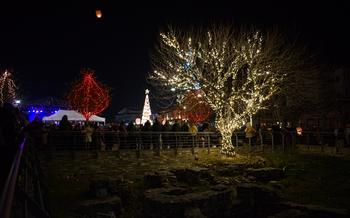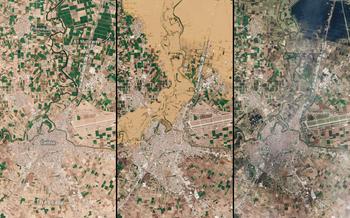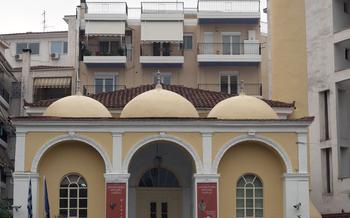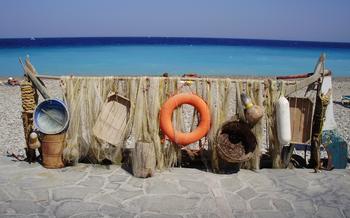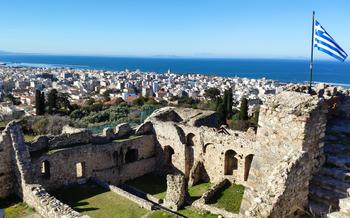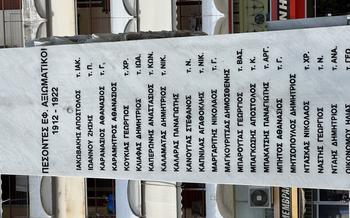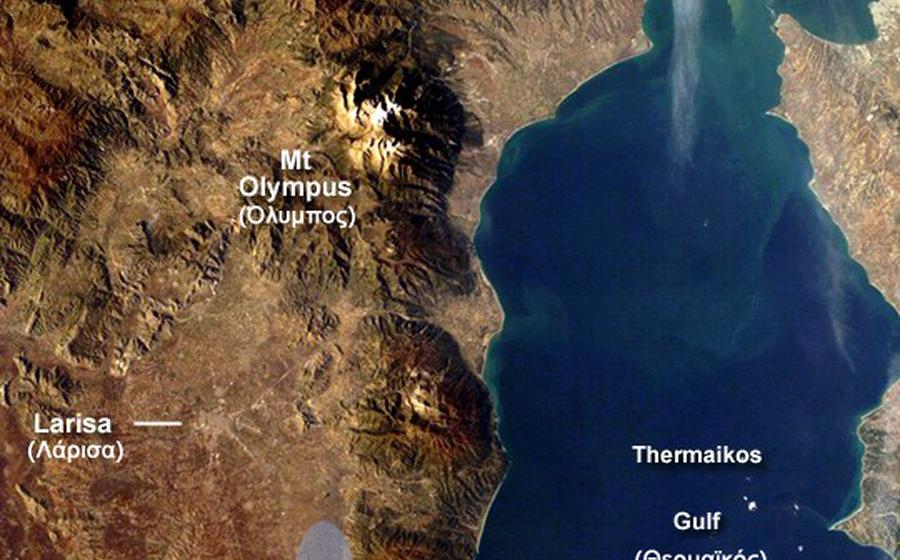
Monastery of Saint Paraskevi
- The Monastery of Saint Paraskevi: A Hidden Gem in Larissa
- Location and Accessibility:
- Historical Background
- Architectural Features:
- Religious Significance
- Cultural Importance
- Legends and Myths
- Visiting the Monastery: Practical Considerations
- Highlights for Visitors
- Guided Tours and Workshops
- Accommodation and Dining Options
- Things to Do in the Surrounding Area
- Travel Tips and Practical Information
- Photography and Social Media
- Insider Tip: Special Events and Festivals
The Monastery of Saint Paraskevi: A Hidden Gem in Larissa
Nestled among the rolling hills of Larissa, Greece, lies a hidden gem waiting to be discovered. The Monastery of Saint Paraskevi, with its rich history, architectural splendor, and religious significance, offers a glimpse into the cultural and spiritual heritage of the region.
History
The monastery's origins can be traced back to the 16th century, when it was founded by a humble monk seeking a life of devotion. Over the centuries, it has undergone several renovations and expansions, reflecting the changing times and evolving needs of the monastic community.
Architecture
The monastery's exterior is characterized by its imposing stone walls and elegant arched entrance. Inside, visitors are greeted by a tranquil courtyard adorned with cypress trees and colorful flowerbeds. The interior of the church features intricate frescoes and icons, depicting scenes from the life of Saint Paraskevi and other religious figures.
Cultural Significance
The Monastery of Saint Paraskevi holds a special place in the hearts of the local community. It is considered a sacred site, revered for its spiritual power and the miracles attributed to its patron saint. Pilgrims from across the region flock to the monastery to seek blessings, offer prayers, and pay homage to Saint Paraskevi.
Legends and Myths
The monastery is steeped in local folklore and mythology. Legends abound about the miraculous powers of Saint Paraskevi, who is believed to have healed the sick, protected the faithful from harm, and even performed miracles during times of war.
Location and Accessibility:
The Monastery of Saint Paraskevi is conveniently located within easy reach of Larissa, the capital city of Thessaly. The exact address is 28th of October Street, in the village of Nea Poli, just 8 kilometers east of Larissa city center.
To get to the monastery, you can opt for public transportation or self-drive. If you prefer public transport, you can take a bus from Larissa's central bus station to Nea Poli, which takes approximately 20 minutes. From Nea Poli, you can walk to the monastery, which is only a few minutes away.
If you're driving, the journey from Larissa to the monastery takes about 15 minutes. Simply follow the signs for Nea Poli and the monastery will be on your left as you enter the village. Ample parking space is available on-site, making it convenient for visitors arriving by car.
Historical Background
The foundations of the Monastery of Saint Paraskevi date back to the Byzantine era. It is believed that the monastery was initially established in the 10th century and has undergone several renovations and expansions over the centuries. According to legend, an image of Saint Paraskevi appeared in a dream to a local shepherd, who was guided to the site of the monastery.
The monastery played a significant religious and community role throughout the Ottoman period. It served as a spiritual center for the local Orthodox Christian population and was often a refuge for those fleeing persecution. During the Greek War of Independence in the 19th century, the monastery provided support and shelter to Greek fighters and contributed to the struggle for freedom.
In the 20th century, the monastery underwent a period of decline due to political and economic turmoil. However, in recent decades, it has experienced a revival and is now a popular destination for pilgrims and visitors from around the world.
Architectural Features:
The Monastery of Saint Paraskevi showcases a captivating blend of architectural styles, harmoniously merging Byzantine and Ottoman influences. Its exterior design commands attention with its sturdy stone walls adorned with intricate carvings and decorative elements. The monastery's courtyard, an oasis of tranquility, features a mesmerizing fountain and vibrant flowerbeds, providing a welcoming entrance to the sacred space.
Stepping inside the monastery, visitors are greeted by an awe-inspiring interior layout that exudes both grandeur and simplicity. The main church, the heart of the monastery, boasts an impressive vaulted ceiling adorned with breathtaking frescoes and religious icons. The iconostasis, a magnificent partition separating the sanctuary from the nave, is intricately carved with intricate designs and embellished with gold leaf, creating a sense of reverence and devotion.
Throughout the monastery, visitors can admire notable architectural elements that speak to its rich history and artistic heritage. The bell tower, a symbol of the monastery's enduring presence, rises majestically above the surrounding landscape, its melodious chimes resonating through the valley. The refectory, where monks once gathered for meals, features a long, communal table and a vaulted ceiling, creating a sense of camaraderie and shared purpose.
The monastery's frescoes and icons, vibrant and expressive, depict scenes from the Bible, the lives of saints, and significant historical events. These exquisite artworks, meticulously crafted by talented artisans, bring the stories they portray to life, offering visitors a glimpse into the monastery's spiritual and historical significance.
Religious Significance
The Monastery of Saint Paraskevi is a significant pilgrimage site for Orthodox Christians, particularly those in the region of Thessaly and beyond. Devotees from all over the country come to pay their respects to Saint Paraskevi, the patron saint of the monastery, and seek her blessings and guidance.
The monastery is home to a revered icon of Saint Paraskevi, believed to have miraculous powers and capable of granting wishes and healing the sick. Pilgrims often make offerings of candles, flowers, and other religious objects as a display of devotion and gratitude.
Throughout the year, the monastery hosts various religious ceremonies and events, attracting a large number of visitors. In particular, the annual feast day of Saint Paraskevi, celebrated on July 26th, is a major religious festival that draws thousands of pilgrims from across the region. During this time, special services are conducted, and the icon of the saint is carried in a solemn procession around the monastery grounds.
The presence of the holy icon and the belief in the miraculous powers of Saint Paraskevi contribute greatly to the religious significance of the monastery, making it a sacred place for Orthodox Christians in Greece and beyond.
Cultural Importance
The Monastery of Saint Paraskevi holds a significant place in the cultural fabric of Larissa. It serves as a focal point for local traditions and customs, deeply intertwined with the spiritual and historical heritage of the region. Throughout the year, the monastery plays host to various annual festivals and celebrations that attract both pilgrims and visitors alike. These events showcase the rich cultural traditions of the area, often featuring traditional music, dance, and culinary delights. The monastery also contributes to the preservation of local crafts and artisanal skills, providing a platform for artisans to display and sell their handcrafted goods. Moreover, the monastery's commitment to education and cultural preservation has led to the establishment of a museum and exhibition space within its premises. This space showcases religious artifacts, historical documents, and traditional costumes, offering visitors a glimpse into the cultural heritage of Larissa.
Legends and Myths
The Monastery of Saint Paraskevi is shrouded in local folklore and traditions, giving rise to numerous legends and myths that have been passed down through generations. One of the most famous legends tells the story of a young woman named Paraskevi who lived in the area during the Byzantine era. According to legend, Paraskevi was known for her piety and devotion to God. One day, while she was praying in the forest, she was attacked by a group of bandits. In her desperation, she called out to God for help, and a miracle occurred. A swarm of bees suddenly appeared and attacked the bandits, driving them away. Paraskevi was unharmed, and from that day on, she was known as Saint Paraskevi, the protector of the weak and helpless.
Another legend associated with the monastery is the story of the healing powers of Saint Paraskevi. It is believed that the saint has the power to heal the sick and the afflicted. Many pilgrims have come to the monastery over the years, seeking her intercession and praying for healing. There are numerous stories of people who have been miraculously cured of their illnesses after visiting the monastery and praying to Saint Paraskevi.
The monastery is also said to be a place of great spiritual power. Many visitors have reported feeling a sense of peace and tranquility while visiting the monastery, and some have even claimed to have experienced visions or other spiritual encounters. The monastery is considered to be a sacred place, and it is believed that anyone who visits with a pure heart and a sincere intention will be blessed by Saint Paraskevi.
Visiting the Monastery: Practical Considerations
Before embarking on your pilgrimage to the Monastery of Saint Paraskevi, it is essential to be aware of the visiting hours and days. The monastery welcomes visitors from Tuesday to Sunday, with specific hours designated for each day. It is advisable to plan your visit accordingly to avoid disappointment.
When visiting the monastery, it is important to adhere to the dress code and etiquette expected of visitors to religious sites. Modest attire that covers your shoulders and knees is recommended, out of respect for the sanctity of the environment.
Photography and videography are generally permitted within the monastery, but it is crucial to be respectful and mindful of the religious significance of the site. Avoid using flash photography and disturbing the peace and tranquility of the monastery during services or other religious observances.
The Monastery of Saint Paraskevi is committed to accessibility for visitors with disabilities. Wheelchair ramps and accessible pathways have been installed to ensure that everyone can experience the beauty and spirituality of the monastery. Please inquire with the monastery staff if you require any assistance or accommodations.
Highlights for Visitors
Visitors to the Monastery of Saint Paraskevi are in for a treat, as there are several notable artifacts, relics, and attractions that make the experience truly enriching. One highlight is the icon of Saint Paraskevi, which is believed to have miraculous powers and is a major draw for pilgrims and visitors alike. The icon is adorned with intricate gold and silverwork, and it is believed to date back to the 13th century.
In addition to the icon, the museum and exhibition spaces at the monastery provide a fascinating glimpse into the history, culture, and religious traditions of the region. Visitors can learn about the founding of the monastery, view artifacts from its past, and see temporary exhibitions that often showcase local artists and artisans.
The scenic views from the monastery are also a highlight. The monastery is situated on a hilltop overlooking the city of Larissa, and visitors can enjoy panoramic views of the surrounding countryside. The lush gardens and serene atmosphere of the monastery grounds provide a tranquil oasis for visitors to relax and reflect.
Guided Tours and Workshops
The Monastery of Saint Paraskevi offers guided tours for visitors who wish to delve deeper into its history, architecture, and religious significance. These tours are conducted by knowledgeable guides who provide detailed explanations and insights into the monastery's past and present. Guided tours are available in several languages to cater to international visitors.
In addition to guided tours, the monastery also hosts specialized workshops and programs throughout the year. These workshops focus on various aspects of the monastery's heritage, such as icon painting, traditional crafts, and Byzantine music. Visitors can participate in these workshops to learn new skills, deepen their understanding of Greek culture, and create their own unique souvenirs to take home.
These guided tours and workshops offer an immersive and educational experience for visitors, allowing them to connect with the monastery's rich history and cultural significance in a meaningful way.
Accommodation and Dining Options
There are several accommodation options available near the Monastery of Saint Paraskevi for visitors who wish to extend their stay in Larissa. The city offers a range of hotels, guesthouses, and apartments to suit different budgets and preferences.
For a comfortable and convenient stay, the Hotel Larissa is located just a short drive from the monastery. It offers modern amenities, spacious rooms, and a friendly atmosphere. Alternatively, the traditional Guesthouse To Archontiko provides a more rustic and authentic experience with charming rooms and a cozy ambiance.
When it comes to dining, visitors can indulge in the delectable flavors of traditional Greek cuisine at the tavernas and restaurants in the surrounding area. The region is renowned for its fresh seafood, grilled meats, and delicious homemade dishes.
For those with dietary restrictions, vegetarian and vegan options are also available at some restaurants in Larissa. Visitors can savor the local specialties such as "gemista" (stuffed tomatoes and peppers), "spanakorizo" (spinach and rice dish), and "fasolada" (bean soup).
Whether you prefer a luxurious hotel experience or the charm of a traditional guesthouse, Larissa offers a variety of accommodation options to complement your visit to the Monastery of Saint Paraskevi.
Things to Do in the Surrounding Area
Beyond the Monastery of Saint Paraskevi, Larissa offers a plethora of enticing attractions and activities to enrich your trip. Immerse yourself in the region's rich history by exploring ancient ruins, Byzantine churches, and Ottoman fortifications. Take advantage of the stunning natural landscapes by embarking on invigorating hikes through lush forests, cycling along scenic trails, or basking in the sun on pristine beaches. Discover the vibrant local culture by attending traditional festivals, indulging in delectable Greek cuisine, and engaging with the warm and welcoming people of Larissa.
Nearby Attractions and Activities:
-
Historical Sites: Visit the ancient city of Larisa, with its impressive acropolis and well-preserved ruins. Explore the 13th-century Larissa Castle, a majestic fortress that offers panoramic views of the surrounding countryside.
-
Natural Landscapes: Immerse yourself in the beauty of the Thessalian Plain, renowned for its verdant landscapes and picturesque villages. Hike through the scenic Meteora Valley, a UNESCO World Heritage Site, and marvel at the awe-inspiring monasteries perched atop towering rock formations.
-
Day Trips and Excursions: Take a day trip to the picturesque town of Volos, known for its vibrant port and delicious seafood. Visit the nearby Mount Pelion, a verdant paradise with charming villages, traditional tavernas, and opportunities for outdoor activities.
Travel Tips and Practical Information
When planning your trip to the Monastery of Saint Paraskevi, it's essential to consider practical information to ensure a smooth and enjoyable visit.
Currency and Exchange Rates: - The official currency of Greece is the euro (€). Exchange rates are subject to fluctuations, so check the latest rates before your trip. Consider carrying a combination of cash and credit/debit cards for convenience.
Local Customs and Etiquette: - Dress modestly when visiting the monastery. Avoid shorts, tank tops, and revealing clothing out of respect for the religious nature of the site. - Observe silence and avoid loud conversations within the monastery grounds to maintain a peaceful atmosphere.
Emergency Contact Information: - Keep the contact information of the local police station, hospital, and tourist information office handy in case of emergencies.
Weather and Climate Conditions: - Larissa experiences hot summers and mild winters. Check the weather forecast before your visit and dress accordingly. Sunscreen, sunglasses, and a hat are recommended during summer months.
By considering these practical aspects, you can fully immerse yourself in the spiritual and cultural significance of the Monastery of Saint Paraskevi while ensuring a safe and enjoyable visit.
Photography and Social Media
The Monastery of Saint Paraskevi offers plenty of photo opportunities for visitors. Capture the stunning exterior and interior architecture, the intricate frescoes and icons, and the serene natural surroundings. Share your photos on Instagram and other social media platforms using hashtags such as #MonasteryofSaintParaskevi, #Larissa, #Greece, and #OrthodoxMonastery. Share your experiences and memories with your followers, inspiring them to embark on their pilgrimage to this hidden gem.
Remember to be respectful and mindful when taking photos, especially during religious ceremonies and events. Ask for permission before photographing people and avoid using flash photography to preserve the sacred atmosphere of the monastery. Embrace the opportunity to document your journey and share the beauty and significance of this holy place with the world.
Insider Tip: Special Events and Festivals
The Monastery of Saint Paraskevi hosts several special events and festivals throughout the year, offering visitors a chance to experience the vibrant local culture and religious traditions. One of the most notable events is the annual panigyri (festival) held on July 26, the feast day of Saint Paraskevi. During this festival, the monastery grounds come alive with music, dancing, and traditional Greek cuisine. Pilgrims and visitors from all over the region gather to celebrate the saint's day, participate in religious ceremonies, and enjoy the festive atmosphere.
Another special occasion is the Holy Week leading up to Easter, when the monastery hosts special services and processions. Visitors can witness the unique traditions and rituals associated with this important religious period in Greece. The monastery also organizes educational workshops and programs throughout the year, providing visitors with an opportunity to learn more about the history, architecture, and cultural significance of the site.


